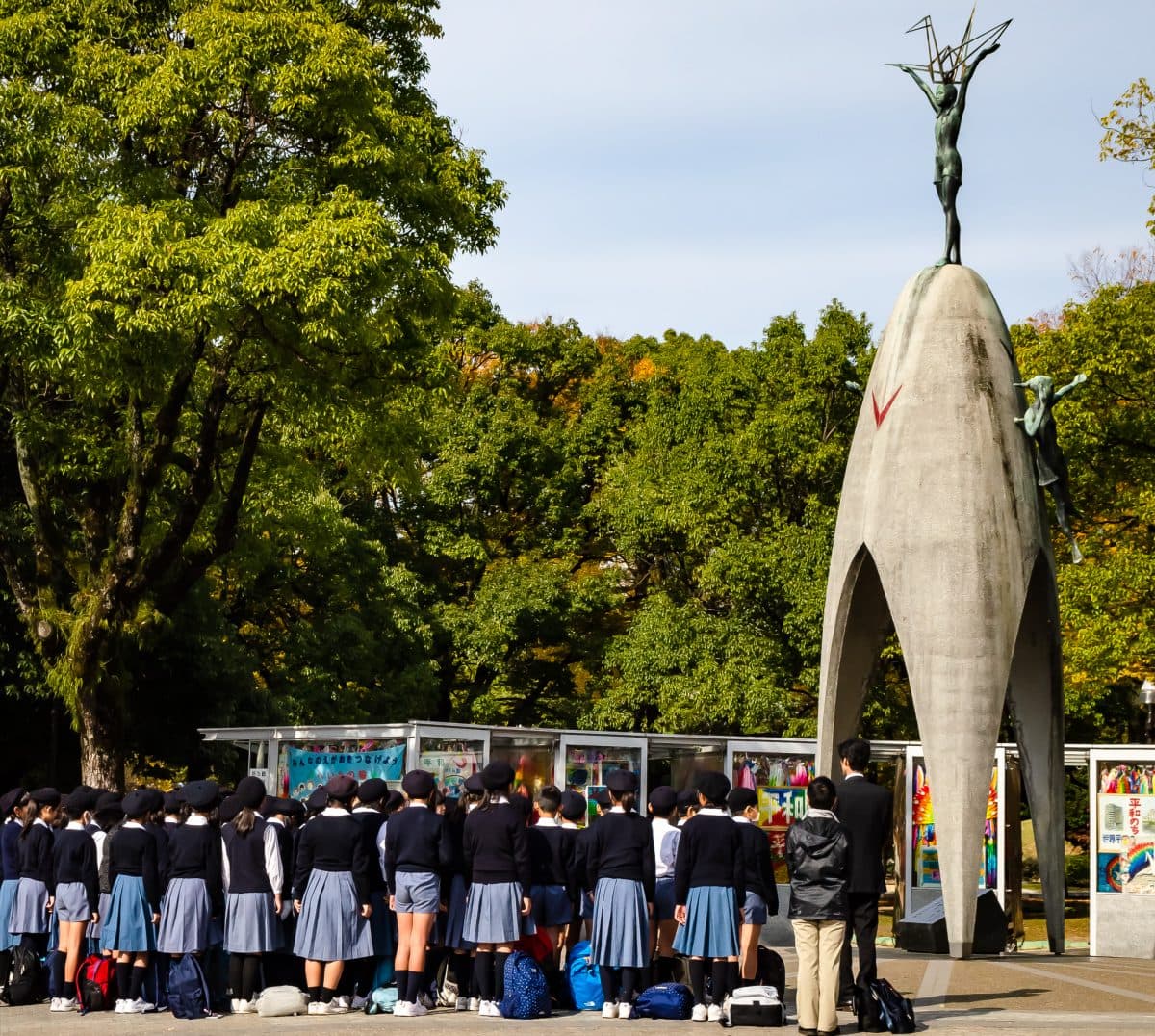Last Updated on 10/27/20 by Rose Palmer
As a teenager, I learned about the devastating effects of the atomic bomb on Hiroshima. As an adult many years later, I visited the Hiroshima Memorial Peace Park, and encountered present day Japanese teenagers learning their history in this living classroom for peace.
This story was recognized with an Honorable Mention in the 2018 North American Travel Journalists Association Competition in the Historical Travel-Online category.
I can’t say that I can clearly recall much of the literature I had to read in school as a teenager. I am sure I analyzed the plight of poor Romeo and Juliet with the best of them. And I remember trying to make sense of talking pigs in George Orwell’s Animal Farm. But there was one book that left a deep impression on me, and I think played a role in developing my adult values and beliefs. Ironically, I don’t remember the title or author, only the topic and the impact it had on me as I read it.
The book described in vivid detail the events that occurred after the first atomic bomb was dropped on the residents of Hiroshima on August 6, 1945. I recall reading with horror and deep sadness about the effects of the radiation poisoning on those that survived the initial blast and then how their bodies gradually decayed as they eventually also died a slow and painful death.
This may seem like an odd subject to have to read as a teenager, but bear in mind that this was in the mid 1970’s. It was barely a little more than one generation since the first atomic bombs were dropped on Japan. The cold war was still going strong and the nuclear arms race was still a competition. Educating a young generation about the devastating effects of the atomic bomb was an exercise in increasing their collective social conscience.
Fast forward about 40 years and nuclear proliferation is still a global hot button. But among all the concerns around continued nuclear testing, there is one place that stands as a constant beacon for peace. Considering the effects the Japanese suffered from the atomic bomb explosions, it is not surprising that a strong anti nuclear peace movement developed in Japan starting in the 1950’s. The Hiroshima Memorial Peace Park commemorates the victims from the nuclear bombing and acts as a focus for Japan’s continuing peace culture.
I recently visited the city of Hiroshima in Japan, and I have to admit that I was amazed at what I saw. I am not sure what I expected, but 70+ years since the bombing is a life time. More than long enough for the phoenix to rise up out of the ashes. It is also long enough that some of the buildings are actually even looking a little drab and tired and could use the benefit of a face lift. In my opinion, this vibrant, active cityscape is just as much a memorial to the resilience and strength of the atomic bomb survivors, as the actual Memorial Peace Park.

Walking the city streets toward the memorial park, you actually have to go out of your way to find the nondescript marker that identifies the hypocenter – ground zero above which the bomb exploded about 1500 ft in the air. A placard describes how the area beneath the blast suffered temperatures of 3000°C to 4000°C along with all of the radiation and the blast shock wave. Anything organic would have been incinerated instantaneously at such temperatures.
Atomic Bomb Dome
About one block from the hypocenter is the most imposing symbol of the Hiroshima Peace Park area, the Atomic Bomb Dome. This building, which was once an exhibition hall, is the only structure near the explosion’s center that survived in any capacity. The surviving skeleton has been maintained as it was left by the bombing, and was designated a UNESCO World Heritage Site in 1996.
This close to ground zero, it is miraculous that anything survived a blast that was equivalent to dropping 15,000 tons of TNT. The blast disintegrated everything within a one mile radius of its center, and caused destruction in a five mile area – essentially 2/3 of the city.

Today, the A Bomb Dome stands in a beautifully landscaped green oasis. Now, surrounded by a thriving and busy city that is also a popular tourist destination, it is hard to imagine the total devastation that would have blanketed the area after the bombing.

Hiroshima Memorial Peace Park
Memorial Cenotaph
Across the river from the A Bomb dome is the Hiroshima Memorial Peace Park. Before the war, this area had been the Nakajima district, and was described as the lively shopping and entertainment center of Hiroshima. The park has many memorials, monuments and sculptures, but the centerpiece is the monument that covers a cenotaph inscribed with the names of all those that died from the nuclear bombing.
Behind the cenotaph memorial is the Peace Flame which has burned continuously since 1964 and will not be extinguished until all threat of nuclear bombing has been eliminated.

Children’s Peace Monument
The Children’s Peace Monument has to be one of the most moving memorials in the park. It was built with the contributions from 3200 Japanese schools and nine countries. At its base is a plaque that reads:
“This is our cry, this is our prayer: for building peace in this world”.
The monument is dedicated to all the children that died as a result of the bombing. Sadly, there were many children in Hiroshima’s city center on Aug. 6, 1945. Many 11 to 14 year old students had been mobilized to demolish houses in order to create fire breaks.
The story behind the design of the Children’s Peace Monument is even more touching. The sculpture is that of a girl holding a crane and is based on the real life story of Sadako Sasaki. Sadako was two years old when the atomic bomb was dropped over Hiroshima and lived a little over one mile from ground zero. She and her parents survived the blast, but at the age of 12, she developed leukemia as a result of the radiation from the atomic bomb.
In the hospital Sadako learned of the Japanese legend that promised that a wish would be granted to anyone that folded 1000 paper origami cranes. Her wish was for a world without nuclear weapons. One version of the story says that she only managed to make 644 paper cranes before she died on Oct. 12, 1955. The story goes on to say that her classmates went on to make 1000 paper cranes which were buried with her. Today, many come to this monument to donate paper cranes as a continuing symbol for the desire for peace.
A Continuing Classroom for Peace
As I approached the Children’s Peace Monument, I encountered one of those serendipitous travel moments that cannot be planned but for which you have to stop so that you can immerse yourself in the experience. In this case, a class of Japanese school students was gathered in front of the Children’s Peace Monument and was singing acapella. Everyone walking by had stopped and gathered around them to listen. There were no other sounds – just the chorus of young voices paying homage to a better world.
Listening to those innocent voices sing in this location and knowing what the monument represented was an extremely moving moment. Afterwards, I asked one of the adults what they were singing, and was told in broken English that the song was for the “Grace of the Earth”.
While this first group of students was singing, another class was sitting on the ground behind them, patiently waiting their turn. This group also brought a box of origami paper cranes-presumably 1000 of them. Once it was their turn, they did a recitation in chorus and then donated the paper cranes to the growing collection on display in the cases around the statue.
Once the class of students had paid their respects to the Children’s Peace Monument, they separated into small groups with an adult guide, and dispersed to learn the lessons from the other monuments scattered around the park.

I continued to walk around the park and explored a few of the key monuments. At each one, I encountered a small group of teenage students, attentively listening to their instructor and taking notes. I was struck by how focused these students were to the topic.
There was no horseplay, no shuffling of feet, no looking at their cell phones, no side conversation with their friends – in short, not typical behavior from any teenagers I have known. Was this normal Japanese student behavior or was it this somber environment that brought out the best in them? I’ll never know. And unfortunately, since I don’t speak Japanese, I could not eavesdrop to hear what their instructors were telling them.
Atomic Bomb Memorial Mound
Not far from the Children’s Peace Monument is this large grass-covered mound which is the burial site for the ashes of 70,000 unidentified victims of the atomic bombing. The bodies were collected from the blast zone and cremated, and the ashes entombed in this spot.

Peace Bell
Nearby is the Peace Bell which visitors are encouraged to ring as a voice for peace.
Cenotaph for Korean Victims
Another meaningful monument is the Cenotaph for Korean Victims. During WWII, Korea was a Japanese colony, and many Korean nationals were living and working in Japan, many not by their choice. Accounts say that at least 10% of the population in the city was Korean at that time.
It is estimated that 20,000 or more Koreans were killed by the atomic bombing in Hiroshima and this memorial recognizes the Korean victims from that day. Koreans believe that their souls ride up to heaven on the backs of a turtle, which is why a turtle statue figures so prominently in this monument.

The Hiroshima Memorial Peace Park has many more monuments as well as a few museums that I did not have the time to visit on this trip – next time. But what I did see left a profound impression.
The sad reality is that Hiroshima and Nagasaki were chosen as targets for the atomic bombs because they were cities with large populations that were still relatively undamaged by the war. The populations were primarily civilian except in Hiroshima which did have about 40,000 military personnel.
Depending on the reference, the numbers vary slightly, but of the roughly 250,000 people living in Hiroshima on Aug. 6, 1945, about two thirds, or 150,000 people died as a result of the atomic bomb – with about half of those deaths occurring at the time of the blast. That would be like losing every man, woman and child in Syracuse, New York, or Kansas City, Kansas, or Pasadena, California.
The Hiroshima Memorial Peace Park gets about 1.5 million visitor a year, with about one fifth of those being international visitors. While that seems like a large number, it is only about 0.02% of our planet’s population. That is a small number of people who have a chance to learn and be inspired by the history lessons this site continues to teach.
Please share this story with everyone you know, especially the teenagers in your life, so that all those that do not have the chance to visit the Hiroshima Memorial Peace Park can learn from this classroom that continues to promote the proliferation of PEACE.
For first hand accounts by survivors of the Hiroshima and Ngasaki atomic bombings, please visit this site.
If you would like to learn how to make your own paper cranes, this site has good instructions.
To read more of my stories about my travels to Japan please visit https://quiltripping.com/category/travel/asia/japan/
Do you have thoughts or comments about this post? I would love to hear from you on my facebook page.
Thanks for visiting.
Rose
Pin this!

















